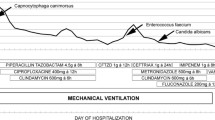Abstract
Capnocytophaga canimorsus is a Gram-negative bacillus of the commensal flora of dogs and cats that can cause infections in humans through bites, scratches or contact with oral secretions. It can be difficult to identify in clinical microbiology laboratories because of the need for specific culture media. We present the case of a patient with no relevant medical history who was admitted with septic shock, where blood smear examination was crucial for the etiologic diagnosis of Capnocytophaga canimorsus infection. The patient was also diagnosed Pelger-Huët anomaly, a condition causing a defect in neutrophil chemotaxis, which may have contributed to the severity of the infection.



Similar content being viewed by others
References
Butler T. Capnocytophaga canimorsus: an emerging cause of sepsis, meningitis, and post-splenectomy infection after dog bites. Eur J Clin Microbiol Infect Dis Off Publ Eur Soc Clin Microbiol. 2015;34(7):1271–80.
Bertin N, Brosolo G, Pistola F, Pelizzo F, Marini C, Pertoldi F, et al. Capnocytophaga canimorsus: an emerging pathogen in immunocompetent patients-experience from an emergency department. J Emerg Med. 2018;54(6):871–5.
Roscoe DL, Zemcov SJ, Thornber D, Wise R, Clarke AM. Antimicrobial susceptibilities and beta-lactamase characterization of Capnocytophaga species. Antimicrob Agents Chemother. 1992;36(10):2197–200.
Zangenah S, Abbasi N, Andersson AF, Bergman P. Whole genome sequencing identifies a novel species of the genus Capnocytophaga isolated from dog and cat bite wounds in humans. Sci Rep. 2016;6:22919.
Renzi F, Dol M, Raymackers A, Manfredi P, Cornelis GR. Only a subset of C. canimorsus strains is dangerous for humans. Emerg Microbes Infect. 2015;4(8):e48.
Dedy NJ, Coghill S, Chandrashekar NKS, Bindra RR. Capnocytophaga canimorsus sepsis following a minor dog bite to the finger: case report. J Hand Surg. 2016;41(1):81–4.
Bobo RA, Newton EJ. A previously undescribed gram-negative bacillus causing septicemia and meningitis. Am J Clin Pathol. 1976;65(4):564–9.
Hess E, Renzi F, Karhunen P, Dol M, Lefèvre A, Antikainen J, et al. Capnocytophaga canimorsus Capsular Serovar and Disease Severity, Helsinki Hospital District, Finland, 2000–2017. Emerg Infect Dis. 2018;24(12):2195–201.
Pers C, Gahrn-Hansen B, Frederiksen W. Capnocytophaga canimorsus septicemia in Denmark, 1982–1995: review of 39 cases. Clin Infect Dis Off Publ Infect Dis Soc Am. 1996;23(1):71–5.
van Samkar A, Brouwer MC, Schultsz C, van der Ende A, van de Beek D. Capnocytophaga canimorsus Meningitis: three cases and a review of the literature. Zoonoses Public Health. 2016;63(6):442–8.
Hästbacka J, Hynninen M, Kolho E. Capnocytophaga canimorsus bacteremia: clinical features and outcomes from a Helsinki ICU cohort. Acta Anaesthesiol Scand. 2016;60(10):1437–43.
Dusse LMS, Moreira AMB. Acquired Pelger-Huët: what does it really mean? Clin Chim Acta. 2010;411(21–22):1587–90.
Woessner S, Florensa L, Sans-Sabrafen J. La Citología óptica en el diagnóstico hematológico. Madrid: Acción Médica; 2009.
Wang E, Boswell E. Pseudo-Pelger-Huët anomaly induced by medications: a clinicopathologic study in comparison with myelodysplastic syndrome-related pseudo-Pelger-Huët anomaly. Am J Clin Pathol. 2011;135(2):291–303.
Colella R, Hollensead S. Understanding and recognizing the Pelger-Huët anomaly. Am J Clin Pathol. 2012;137(3):358–66.
Johnson CA, Bass DA, Trillo AA, Snyder MS, DeChatelet LR. Functional and metabolic studies of polymorphonuclear leukocytes in the congenital Pelger-Huet anomaly. Blood. 1980;55(3):466–9.
Cunningham JM, Patnaik MM. Historical perspective and clinical implications of the Pelger-Hüet cell. Am J Hematol. 2009;84(2):116–9.
Park BH, Dolen J. Defective chemotactic migration of polymorphonuclear leukocytes in Pelger-Huët anomaly. Proc Soc Exp Biol Med. 1977;155:51–5.
González-García A, Ferreiro JJ, López-Lopategui MC, Zabarte M. Septic shock with purpura fulminans due to Capnocytophaga canimorsus. Enferm Infecc Microbiol Clin. 2004;22(5):309–10.
Beernink TMJ, Wever PC, Hermans MHA, Bartholomeus MGT. Capnocytophaga canimorsus meningitis diagnosed by 16S rRNA PCR. Pract Neurol. 2016;16(2):136–8.
Pedersen G, Schønheyder HC, Nielsen LC. Capnocytophaga canimorsus bacteraemia demonstrated by a positive blood smear. A case report. APMIS Acta Pathol Microbiol Immunol Scand. 1993;101(7):572–4.
Chary S, Joshi M, Reddy S, Ryan C, Saddi V. Septicemia due to Capnocytophaga canimorsus following dog bite in an elderly male. Indian J Pathol Microbiol. 2011;54(2):368–70.
Shin H, Mally M, Meyer S, Fiechter C, Paroz C, Zaehringer U, et al. Resistance of Capnocytophaga canimorsus to killing by human complement and polymorphonuclear leukocytes. Infect Immun. 2009;77(6):2262–71.
Stiegler D, Gilbert JD, Warner MS, Byard RW. Fatal dog bite in the absence of significant trauma: Capnocytophaga canimorsus infection and unexpected death. Am J Forensic Med Pathol. 2010;31(2):198–9.
Cooper JD, Dorion RP, Smith JL. A rare case of waterhouse-friderichsen syndrome caused by Capnocytophaga canimorsus in an immunocompetent patient. Infection. 2015;43(5):599–602.
Gaastra W, Lipman LJA. Capnocytophaga canimorsus. Vet Microbiol. 2010;140(3–4):339–46.
Van Dam AP, Jansz A. Capnocytophaga canimorsus infections in The Netherlands: a nationwide survey. Clin Microbiol Infect Off Publ Eur Soc Clin Microbiol Infect Dis. 2011;17(2):312–5.
Hloch O, Mokra D, Masopust J, Hasa J, Charvat J. Antibiotic treatment following a dog bite in an immunocompromized patient in order to prevent Capnocytophaga canimorsus infection: a case report. BMC Res Notes. 2014;7:432.
Author information
Authors and Affiliations
Corresponding author
Ethics declarations
Conflict of interest
The authors declare that they have no conflict of interest.
Additional information
Publisher's Note
Springer Nature remains neutral with regard to jurisdictional claims in published maps and institutional affiliations.
About this article
Cite this article
Franco-Serrano, S., Amer-Salas, N., Nieto-Piñar, Y. et al. Septic shock caused by Capnocytophaga canimorsus in a patient with heterozygous Pelger-Huët anomaly. Int J Hematol 116, 807–811 (2022). https://doi.org/10.1007/s12185-022-03400-1
Received:
Revised:
Accepted:
Published:
Issue Date:
DOI: https://doi.org/10.1007/s12185-022-03400-1




